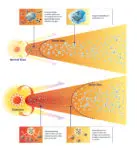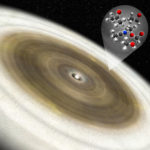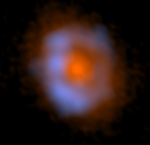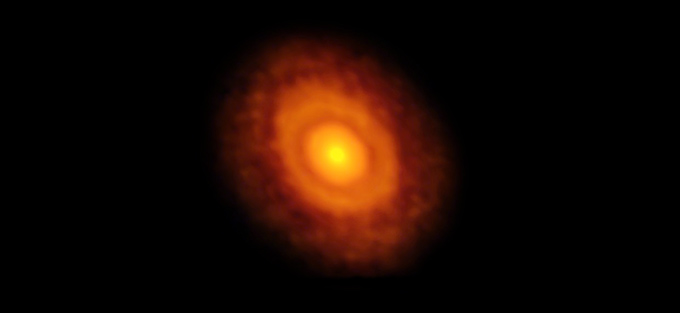Retreating Snow Line Reveals Organic Molecules Around Young Star
Astronomers using ALMA have detected various complex organic molecules around the young star V883 Ori. A sudden outburst from this star is releasing molecules from the icy compounds in the planet forming disk. The chemical composition of the disk is similar to that of comets in the modern Solar System. Sensitive ALMA observations enable astronomers to reconstruct the evolution of organic molecules from the birth of the Solar System to the objects we see today.
The research team led by Jeong-Eun Lee (Kyung Hee University, Korea) used the Atacama Large Millimeter/submillimeter Array (ALMA) to detect complex organic molecules including methanol (CH3OH), acetone (CH3COCH3), acetaldehyde (CH3CHO), methyl formate (CH3OCHO), and acetonitrile (CH3CN). This is the first time that acetone was unambiguously detected in a planet forming region or protoplanetary disk.
Various molecules are frozen in ice around micrometer-sized dust particles in protoplanetary disks. V883 Ori’s sudden flare-up is heating the disk and sublimating the ice, which releases the molecules into gas. The region in a disk where the temperature reaches the sublimation temperature of the molecules is called the “snow line.” The radii of snow lines are about a few astronomical units (au) around normal young stars, however, they are enlarged almost 10 times around bursting stars.
“It is difficult to image a disk on the scale of a few au with current telescopes,” said Lee. “However, around an outburst star, ice melts in a wider area of the disk and it is easier to see the distribution of molecules. We are interested in the distribution of complex organic molecules as the building blocks of life.”
Ice, including frozen organic molecules, could be closely related to the origin of life on planets. In our Solar System, comets are the focus of attention because of their rich icy compounds. For example, the European Space Agency’s legendary comet explorer Rosetta found rich organic chemistry around the comet Churyumov-Gerasimenko. Comets are thought to have been formed in the outer colder region of the proto-Solar System, where the molecules were contained in ice. Probing the chemical composition of ice in protoplanetary disks is directly related to probing the origin of organic molecules in comets, and the origin of the building blocks of life.
Thanks to ALMA’s sharp vision and the enlarged snow line due to the flare-up of the star, the astronomers obtained the spatial distribution of methanol and acetaldehyde. The distribution of these molecules has a ring-like structure with a radius of 60 au, which is twice the size of Neptune's orbit. The researchers assume that inside of this ring the molecules are invisible because they are obscured by thick dusty material, and are invisible outside of this radius because they are frozen in ice.
“Since rocky and icy planets are made from solid material, the chemical composition of solids in disks is of special importance. An outburst is a unique chance to investigate fresh sublimates, and thus the composition of solids.” says Yuri Aikawa at the University of Tokyo, a member of the research team.
V883 Ori is a young star located at 1300 light-years away from the Earth. This star is experiencing a so-called FU Orionis type outburst, a sudden increase of luminosity due to a bursting torrent of material flowing from the disk to the star. These outbursts last only on the order of 100 years, therefore the chance to observe a burst is rather rare. However, since young stars with a wide range of ages experience FU Ori bursts, astronomers expect to be able to trace the chemical composition of ice throughout the evolution of young stars.
Note: Another ALMA observation (van't Hoff et al. 2018, ApJL, 864, 23) also detected CH3OH emissions from V883 Ori. However, the sensitivity and resolution of the observations were not enough to resolve the structure inside the water snow line.
Additional Information
These observation results are published as Lee et al. “The ice composition in the disk around V883 Ori revealed by its stellar outburst” in Nature Astronomy on February 4, 2019.
The research team members are:
Jeong-Eun Lee (Kyung Hee University), Seokho Lee (Kyung Hee University), Giseon Baek (Kyung Hee University), Yuri Aikawa (The University of Tokyo), Lucas Cieza (Universidad Diego Prtales), Sung-Yong Yoon (Kyung Hee University), Gregory Herczeg (Peking University), Doug Johnstone (NRC Herzberg Astronomy and Astrophysics), Simon Casassus (Universidad de Chile)
This research was supported by the Basic Science Research Program through the National Research Foundation of Korea (grant No. NRF-2018R1A2B6003423), the Korea Astronomy and Space Science Institute under the R&D program supervised by the Ministry of Science, ICT and Future Planning, JSPS KAKENHI (No. 16K13782 and 18H05222), the general grant (No. 11473005) by the National Science Foundation of China, National Research Council of Canada, and NSERC Discovery Grant.
The Atacama Large Millimeter/submillimeter Array (ALMA), an international astronomy facility, is a partnership of the European Organisation for Astronomical Research in the Southern Hemisphere (ESO), the U.S. National Science Foundation (NSF) and the National Institutes of Natural Sciences (NINS) of Japan in cooperation with the Republic of Chile. ALMA is funded by ESO on behalf of its Member States, by NSF in cooperation with the National Research Council of Canada (NRC) and the Ministry of Science and Technology (MOST) in Taiwan and by NINS in cooperation with the Academia Sinica (AS) in Taiwan and the Korea Astronomy and Space Science Institute (KASI).
ALMA construction and operations are led by ESO on behalf of its Member States; by the National Radio Astronomy Observatory (NRAO), managed by Associated Universities, Inc. (AUI), on behalf of North America; and by the National Astronomical Observatory of Japan (NAOJ) on behalf of East Asia. The Joint ALMA Observatory (JAO) provides the unified leadership and management of the construction, commissioning and operation of ALMA.
Images
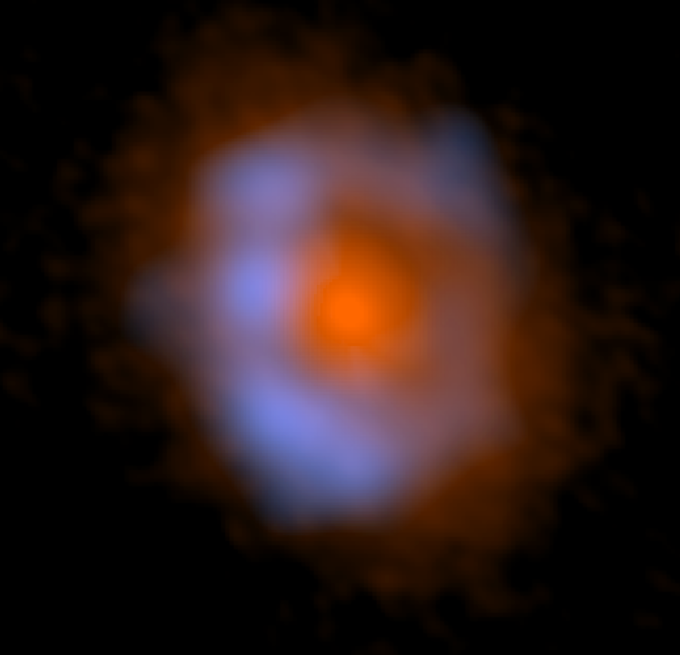
False-color image of V883 Ori taken with ALMA. The distribution of dust is shown in orange and the distribution of methanol, an organic molecule, is shown in blue. Credit: ALMA (ESO/NAOJ/NRAO), Lee et al.
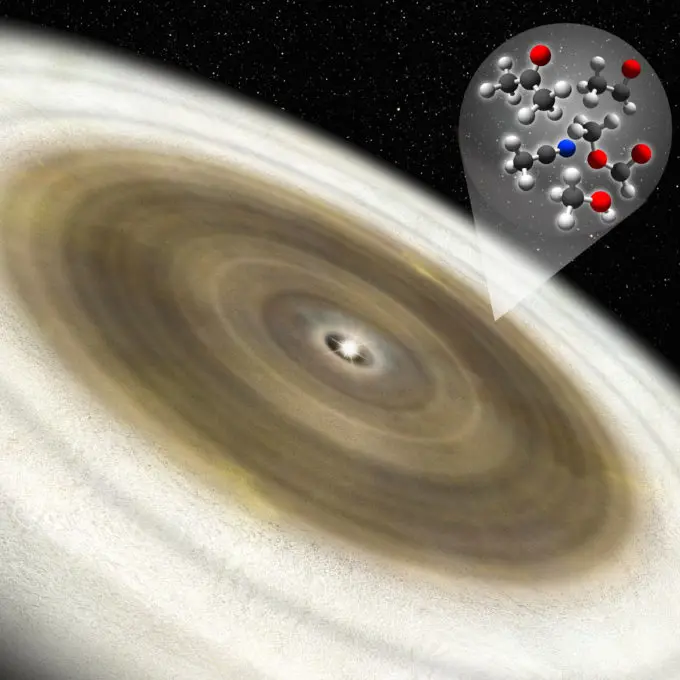
Artist’s impression of the protoplanetary disk around a young star V883 Ori. The outer part of the disk is cold and dust particles are covered with ice. ALMA detected various complex organic molecules around the snow line of water in the disk. Credit: National Astronomical Observatory of Japan.
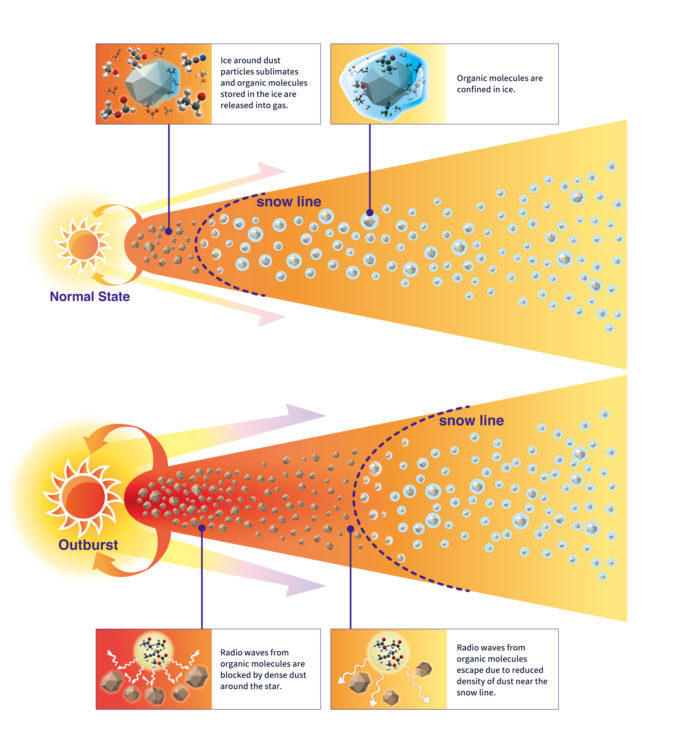
Schematic illustration of the composition of protoplanetary disks in normal state and outburst phase. V883 Ori is experiencing an FU Orionis outburst and the increase in disk temperature pushes the snow line outward, causing various molecules contained in ice to be released into gas. Credit: National Astronomical Observatory of Japan.
Contacts
-
Valeria Foncea
Education and Public Outreach ManagerJoint ALMA Observatory Santiago - ChilePhone: +56 2 2467 6258Cel: +56 9 7587 1963Email: [email protected] -
Masaaki Hiramatsu
Education and Public Outreach Officer, NAOJ Chile -
Charles E. Blue
Public Information OfficerNational Radio Astronomy Observatory Charlottesville, Virginia - USAPhone: +1 434 296 0314Cel: +1 202 236 6324Email: [email protected] -
Calum Turner
ESO Assistant Public Information Officer

